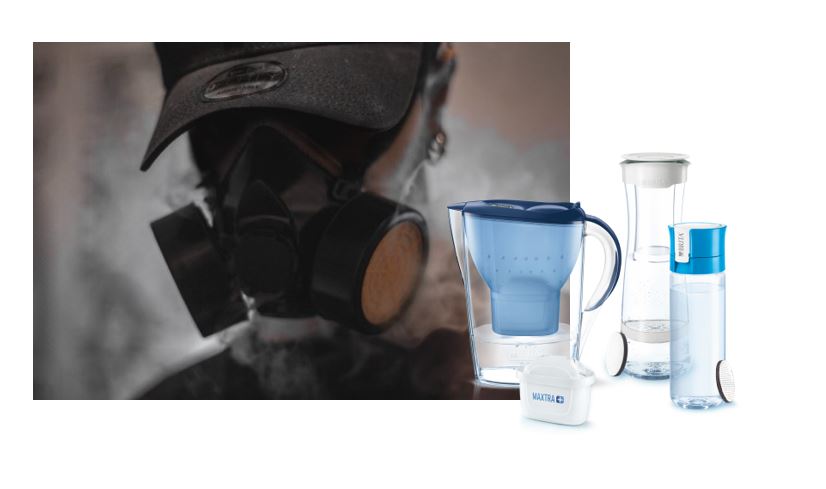
From water purification to gas mask filters: the wide…
W
ith a total sales of 617 million euros in 2020 worldwide, the BRITA Company produces water jugs, kettles and tap attachments integrated with disposable filters. The filters, which contain activated carbon and ion-exchange resin, have the goal to remove substances that may impair taste, to reduce the carbonate hardness (limescale) as well as copper and lead [1]. This process that is performed daily on drinking water at home, is called adsorption. This phenomenon is a separation process involving the selective transfer of solutes (adsorbates) in a fluid phase to the surface of a solid (adsorbent). Through adsorption, small particles or dissolved contaminants in water can be removed. However, adsorption should not be confused with absorption, in which particles penetrate into another substance, just like a sponge that soaks in liquids. While adsorption describes the enrichment of absorbates onto the surface of an adsorbent, absorption is defined as a transfer of a substance from one bulk phase to another bulk phase [2]. The substance is enriched within the receiving phase and not only on its surface, as it can be seen in Figure 1. The dissolution of gases in liquids is a typical example of absorption.

The commonly used material for water treatment through adsorption is activated carbon. This adsorbent is a carbonized and chemically activated material through oxygen treatment, that results in millions of tiny pores between carbon atoms opening up. This highly porous material presents surface area values usually between 500–1500 m2/g and can be used in a powdered or granular form. Due to its active adsorption sites, high surface area, porous structure, surface reactivity, inertness, and thermal stability, this material is a popular choice among adsorbent materials applied industrially [3].
Besides water purification, the adsorption technique has many other applications. Some of them are included in our daily life, such as applying silica or aluminium gels in packaging to remove moisture and control humidity. Others are used industrially, such as the removal of undesirable colouring matter. Adsorbent materials can remove colours from solutions by adsorbing coloured impurities. As shown in Figure 2, Tourmaline, a naturally-occurring borosilicate mineral, was successfully used to remove red dye [4]. Other industrial applications includes the separation of noble gases, where the difference in the degree of adsorption in the adsorbent materials allows to separate a gas mixture; and chromatographic analysis based on selective adsorption to separate a mixture. For example, in column chromatography, a long and wide vertical tube is filled with a suitable adsorbent, and the solution of the mixture is poured from the top and then collected one by one from the bottom [5].

Source: https://doi.org/10.1016/j.arabjc.2016.04.010
Another popular use of the adsorption principle is for gas masks. To filter out harmful gases such as methane, chlorine and sulphur dioxide, the gas mask filters are made with adsorbent materials (usually with activated carbon) to purify the air. From the inlet of the gas mask, the air flows through a particulate filter, followed by an adsorbent filter, and then through another particulate filter, which traps charcoal dust, according to Figure 3 [6].

Source: https://science.howstuffworks.com/gas-mask2.htm
References
[1] BRITA – key facts & figures, 2022. https://www.brita.co.uk/facts-figures (accessed 13/01/2022)
[2] Worch, E. (2021). Adsorption technology in water treatment. de Gruyter.
[3] Soni, R., Bhardwaj, S., & Shukla, D. P. (2020). Various water-treatment technologies for inorganic contaminants: current status and future aspects. In Inorganic Pollutants in Water (pp. 273-295). Elsevier.
[4] Liu, N., Wang, H., Weng, C. H., & Hwang, C. C. (2018). Adsorption characteristics of Direct Red 23 azo dye onto powdered tourmaline. Arabian journal of chemistry, 11(8), 1281-1291.
[5] Application of Adsorption: Definition and Examples, 2022. https://www.embibe.com/exams/application-of-adsorption/ (accessed 13/01/2022)
[6] How Does a Gas Mask Protect Against Chemical Warfare?, 2013. https://www.nationalgeographic.com/science/article/130830-gas-masks-syria-israel-chemical-warfare (accessed 13/01/2022)









